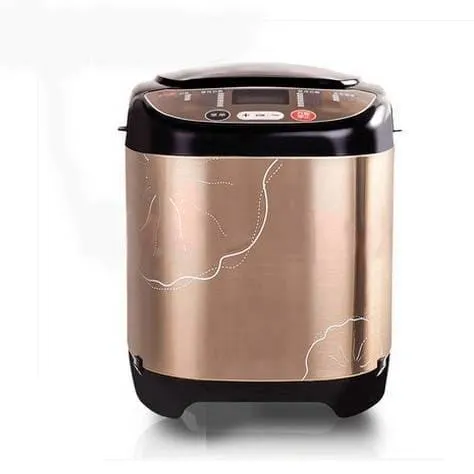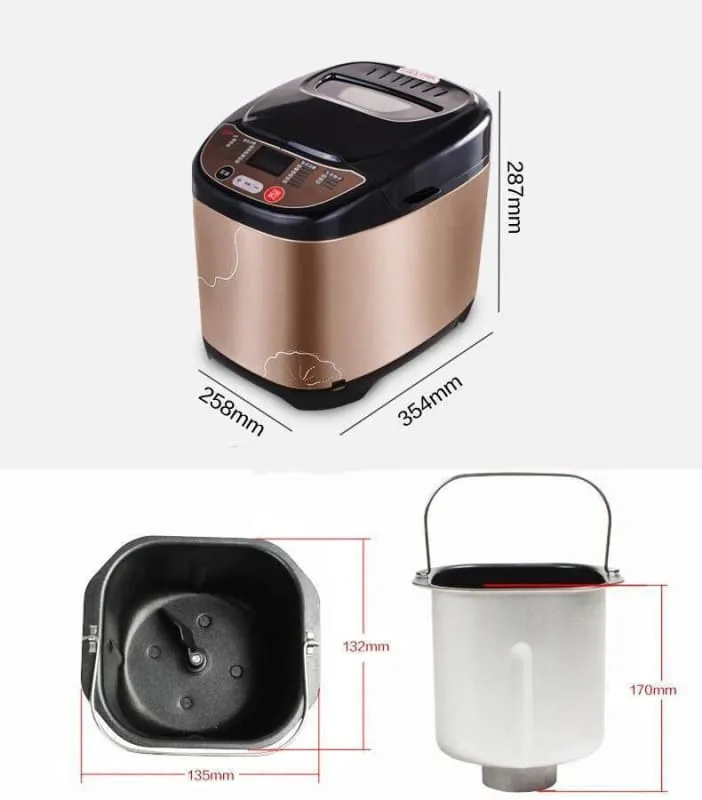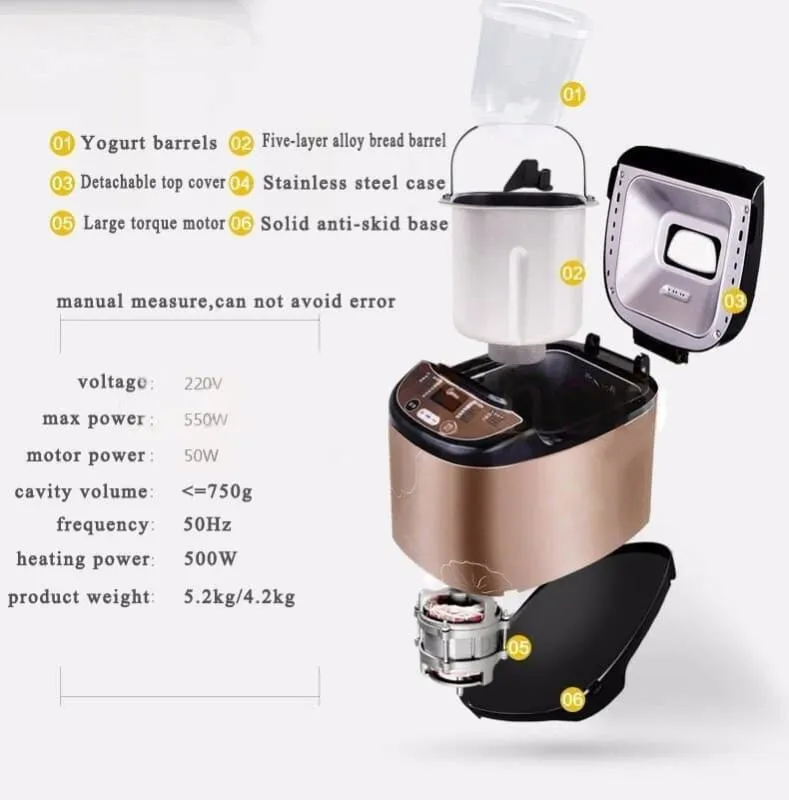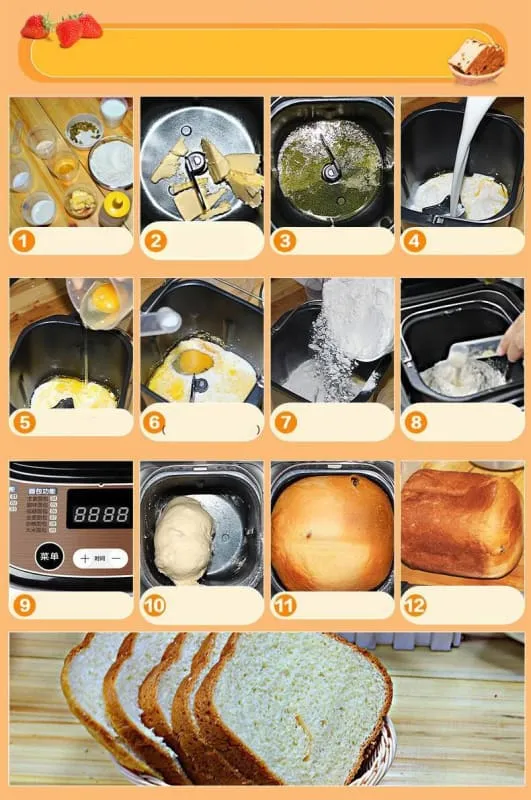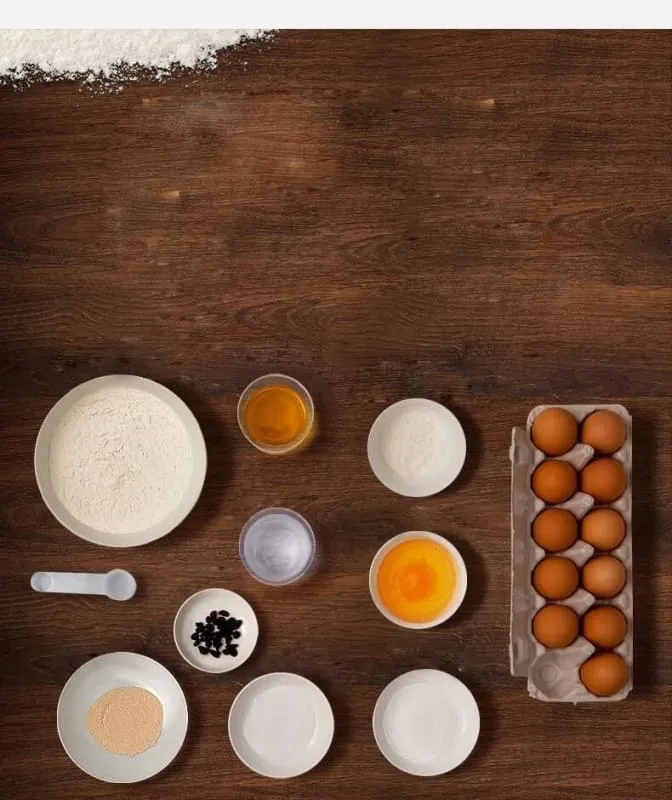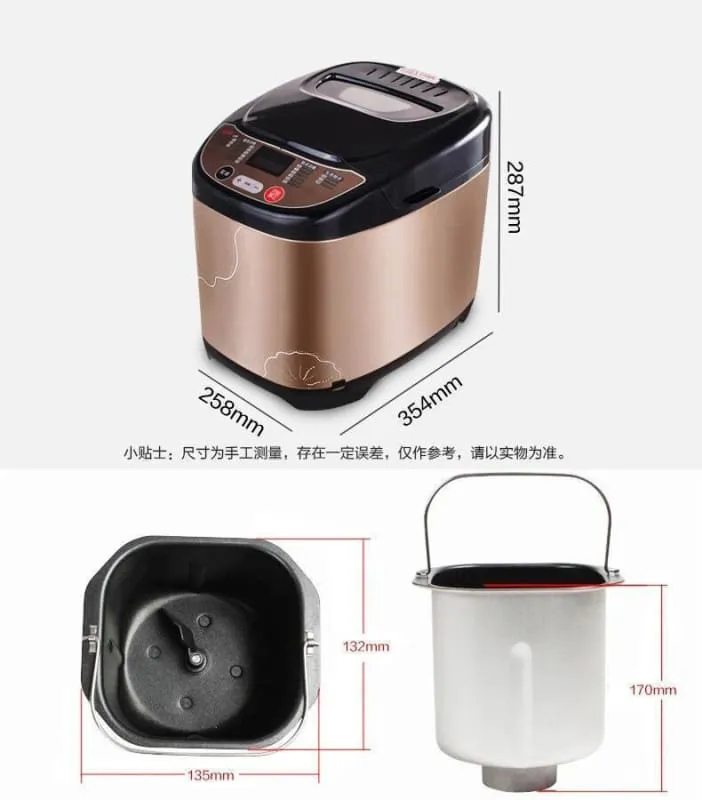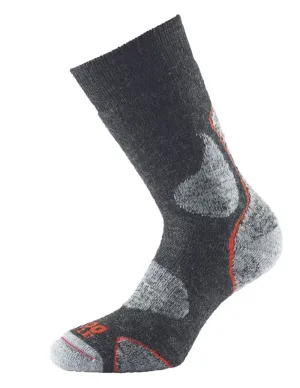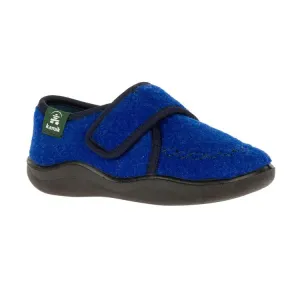Perfect for kitchens with limited counter space, it offers everything you need in a user-friendly design. You can make sourdough, quick breads, gluten-free breads, cakes, or completely homemade recipes—it's up to you!.
It gets the job done at an affordable price while still offering a full set of features
The steps for making breads:
1. Prepare the bread ingredients
2 .baking buffet menu with melted butter
3 .Melt the butter and cooled
4 Add milk
5. Then add 5 eggs
6. then add salt and sugar
7. added high-gluten bread flour
8. buried in the yeast bread flour
9 .Select staple bread function
10. automatic one side and fermented baked
For most of our married life, my husband and I haven’t bought any bread from the store. We’ll occasionally grab a loaf of something if it looks especially tasty, or if it’s on sale for a really good price, but in general, my husband bakes all our bread. He used a bread machine until it broke around five years ago, and ever since then, he’s done it the old-fashioned way: kneading the dough by hand.
Over the years, we’ve learned that home-baked bread is a great way to cut your grocery bill. Our homemade bread costs us about half as much per loaf as we’d pay at the store, and it’s tastier and healthier, as well. And the joy of biting into a slice of warm, fresh-baked bread is a pleasure that money can’t buy.
At first, I was worried that baking from scratch would take too much time or effort. But we’ve found that with just a little planning, it can easily become a part of our weekly routine. In fact, we’ve discovered that there are several different ways to fit baking into a tight schedule and turn fresh-baked bread from a once-in-a-while luxury to a regular habit.
The most obvious reason for baking your own bread is to save money – but that’s far from the only reason. Home-baked bread can also be much tastier, more nutritious, and easier to customize to your personal needs. On top of that, there’s the fun of baking. Mixing and kneading can be oddly relaxing, and there’s something very satisfying about slicing into a fresh-baked loaf you made with your own hands.
A one-pound loaf of white bread costs about $1.30 at the grocery store, according to the Bureau of Labor Statistics. Whole-wheat bread is a bit pricier, at around $2 a loaf. And if you favor fancy breads like seven-grain, sourdough, or cinnamon-raisin, you could pay as much as $4 a loaf.
Making your own bread can cut these costs dramatically. As an example, here’s a list of the ingredients for my husband’s basic whole-wheat bread recipe, along with the prices we pay for them:
- 3 1/2 cups whole-wheat flour: $0.78 ($2.99 for a five-pound bag)
- 1/2 cup wheat bran: $0.08 ($1.28 per pound from the bulk bins at our local health-food store)
- 1/4 cup honey: $0.41 ($11.99 for a five-pound jar at the warehouse store)
- 3 tablespoons unsalted butter: $0.19 ($1.99 per pound)
- 2 tablespoons wheat gluten: $0.26 ($5.46 per pound from the bulk bins)
- 4 teaspoons yeast: $0.19 ($4.59 per pound from the bulk bins)
- 1 teaspoon salt: less than $0.01
All told, the ingredients for the bread cost us $1.92 for a recipe that makes two loaves. We also use a little bit of energy running the oven for an hour, which adds an extra $0.12 or so to the price. Even with that cost, our homemade bread still costs around $1 a loaf – about half the price of whole-wheat bread from the store.
Perhaps you’re thinking that a dollar for a loaf of bread isn’t all that cheap. After all, at most big supermarkets, you can pick up a store-brand loaf of white bread for about that price. So, why should you go to the trouble of baking your own?
To understand why, picture a single slice of that one-dollar loaf from the store. Basically, it’s a flat, pale sliver with hardly any substance. If you pick it up in your hand, it feels like it weighs less than a single sheet of paper. If you squeeze your fingers together while you’re holding it, they’ll go straight through it.
A slice of our homemade whole-wheat bread is nothing like that fluffy, wimpy stuff. It’s a hearty, chewy bread that you can really sink your teeth into. It’s full of nutty, yeasty, whole-grain flavor, with a touch of sweetness from the honey. And unlike the store-bought stuff, it doesn’t fall apart under your knife if you try to spread some peanut butter on it.
Of course, it’s possible to buy bread at the store with more substance than those squishy, mass-produced loaves. But the good stuff costs a lot more – as much as four or five bucks a loaf – so you always have a trade-off between good taste and a good price. With home-baked bread, you get both. Plus, as a bonus, you get to enjoy it while it’s fresh and warm from the oven – a benefit no supermarket bread can ever provide.
Those one-dollar loaves of white bread are pretty unimpressive when it comes to nutrition, as well. According to the nutrition calculator at SparkPeople, a single slice of store-bought white bread has about 65 calories, mostly from starch. It has 2.3 grams of protein and less than a gram of fiber. Commercial “wheat bread” is only slightly better, with 2.4 grams of protein and 1 gram of fiber.
By contrast, when I entered the ingredients for our homemade whole-wheat bread into the recipe calculator, I found that a single slice has 2.7 grams of protein and 2.2 grams of fiber. Starting my day with two slices of that keeps me going until lunchtime, where two slices of wussy white-bread toast would probably leave me hungry by mid-morning.
Once again, not all store-bought breads are created equal. You can buy bread at the store that rivals our homemade bread for nutrition, but you’ll pay a lot more for it. By baking our own, we don’t have to compromise between nutrition and cost.
Although my husband’s regular whole-wheat bread has a pretty good amount of fiber, a few years back I went on a high-fiber kick and asked if he could make me one with loads of fiber. He obliged by taking his basic bread recipe and throwing in every high-fiber ingredient he could think of: whole oats, wheat bran, and even some finely ground flax-seeds. It was dense, dark, chewy, and very substantial.
This illustrates one of the best perks of baking your own bread: you can make it however you want. This is especially handy if you’re on a special diet, such as vegan, low-carb, or gluten-free. Special food needs make it hard to find bread in the stores that you can actually eat – and even if you find some, you’ll probably have to pay through the nose for it. A quick search online turns up prices for gluten-free breads ranging from $6 to $10 per loaf.
By baking your own, you can make breads that fit your special needs at a much more reasonable cost. The bloggers at No Gluten, No Problem found that their homemade gluten-free breads and other baked goods were cheaper than store-bought versions by anywhere from 30% to 60%.
As nice as all these perks are, the main reason my husband prefers to make all our bread by hand is that he honestly enjoys it. There’s something about the process of kneading the dough with his own hands that he finds really satisfying. It’s kind of like the fun you used to have playing with modeling clay as a kid – except instead of making little balls that are going to get squished up and put away, you’re making actual food that you’ll get to enjoy later. You can have fun and accomplish something useful at the same time.
But even if playing with dough isn’t your idea of fun, baking your own bread can still provide a lot of enjoyment. It’s very satisfying to pull a golden-topped loaf of bread out of the oven and know that you made it yourself, with your own hands. And having the whole house fill up with the warm, yeasty smell of baking bread is a pleasure everyone who lives with you can share.
Numerous advantages are associated with using a toaster, the main one being you can toast your bread and create a different eating experience. . Funnily enough, the primary function of a toaster is to toast bread. For people who enjoy toasted bread, it is an ideal piece of technology to use in the kitchen.
With a 2-slice toaster, you have double the toasting sessions needed to produce 4 toasts, and that requires twice the energy a 4-slice unit would spend in making the same. You get to conserve energy with a more efficient device which is definitely something you should consider.
In morning with the kids in a mad rush to go to school, and as parents you are also in a hurry to go to work. Imagine that you need to feed the family quickly. Thanks to a 4-slice toaster, prep time for breakfast is cut in half as you easily have 4 slices of toast in one go. Toast is a staple breakfast item for most people which makes the toaster one of the most popular kitchen appliances in the household. These days, everyone is looking for the most practical ways to go about their daily routine and owning a 4-slice toaster is the choice for many homemakers. If you are looking for the perfect toaster for your needs and budget.

 Cart(
Cart(